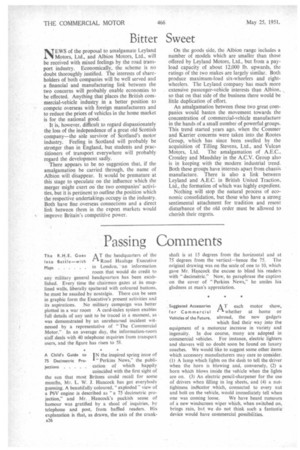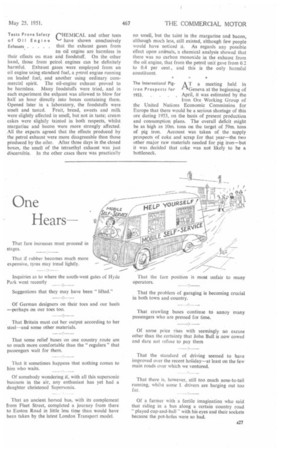Passing Comments
Page 28

Page 29

If you've noticed an error in this article please click here to report it so we can fix it.
The R.H.E. Goes AT the headquarters of the Into Battle—with 1-1 Road Haulage Executive Maps in London, an information
room that would do credit to any military general headquarters has been established. Every time the chairman gazes at its maplined walls, liberally spattered with coloured buttons. he must be assailed by nostalgia. There can be seen in graphic form the Executive's present activities and its aspirations. No military campaign was better plotted in a war room A card-index system enables full details of any unit to be traced in a moment, aswas demonstrated by an unrehearsed incident witnessed by a representative of "The Commercial Motor." In an average day, the information-room staff deals with 40 telephone inquiries from transport users, and the figure has risen to 58.
IN the inspired spring issue of I
"Perkins News," the publication of which happily coincided with the first sight of the sun that most Britons could recall for some months, Mr. L. W. J. Hancock has got everybody guessing. A beautifully coloured," exploded " view of a P6V engine is described as "a 75 .decimetric projection," and Mr. Hancock's puckish sense of humour was gratified by a shoal of inquiries, by telephone and post, from baffled readers. His explanation is that, as drawn, the axis of the crankA26
jections
shaft is at 15 degrees from the horizontal and at 75 degrees from the vertical—hence the 75. The original drawing was on the scale of one to 10, which gave Mr. Hancock the excuse to blind his readers with "decimetric." Now, to paraphrase the caption on the cover of "Perkins News," he smiles his gladness at man's appreciation.
. Suuested Accessories A T each motor show, for Commercial 1—k whether at home or Vehicles of the Future, abroad, the new gadgets
which find their way into the equipment of a motorcar increase in variety and ingenuity. In due course, many are adopted in commercial vehicles. For instance, electric lighters and shavers will no doubt soon be found on luxury coaches. We would like to suggest some other items which accessory manufacturers may care to consider. (1) A lamp which lights on the dash to tell the driver when the horn is blowing and, conversely, (2) a horn which blows inside the vehicle when the lights are on. (3) An electric pencil-sharpener for the use of drivers when filling in log sheets, and (4) a nuttightness indicator which, connected to every nut and bolt on the vehicle, would immediately tell when one was coming loose. We have heard rumours of a new windscreen wiper which, when switched on, brings rain, but we do not think such a fantastic device would have commercial possibilities.
Tests Prove Safety reHEMICAL and other tests of Oil Engine N.." have shown conclusively Exhausts. that the exhaust gases from
an oil engine are harmless in their effects on man and foodstuff. On the other hand, those from petrol engines can be definitely harmful. Exhaust gases were employed from an oil engine using standard fuel, a petrol engine running on leaded fuel, and another using ordinary commercial spirit. The oil-engine exhaust proved to be harmless. Many foodstuffs were tried, and in each experiment the exhaust was allowed to blow for half an hour directly into boxes containing them. Opened later in a laboratory, the foodstuffs were smelt and tasted. Fruit, bread, sweets and milk were slightly affected in smell, but not in taste; cream cakes were slightly tainted in both respects, whilst margarine and bacon were more strongly affected. All the experts agreed that the effects produced by the petrol exhaust were more disagreeable than those produced by the oiler. After three days in the closed boxes, the smell of the tetraethyl exhaust was just discernible. In the other cases there was practically no smell, but the taint in the margarine and bacon, although much less, still existed, although few people would have noticed it. As regards any possible effect upon animals, a chemical analysis showed that there was no carbon monoxide in the exhaust from the oil engine, that from the petrol unit gave from 0.2 to 0.4 per cent., and this is the only harmful Constituent.
The International PigAT a meeting held in Iron Prospects for 1-1Geneva at the beginning of
1953 April, it was estimated by the Iron Ore Working Group of the United Nations Economic Commission for Europe that there would be a serious shortage of this ore during 1953, on the basis of present production and consumption plans. The overall deficit might be as high as 10in. tons on the target of 59m. tons of pig iron. Account was taken of the supply prospects of coke and scrap for that year—the two other major raw materials needed for pig iron—but it was decided that coke was not likely to be a bottleneck.




















































































